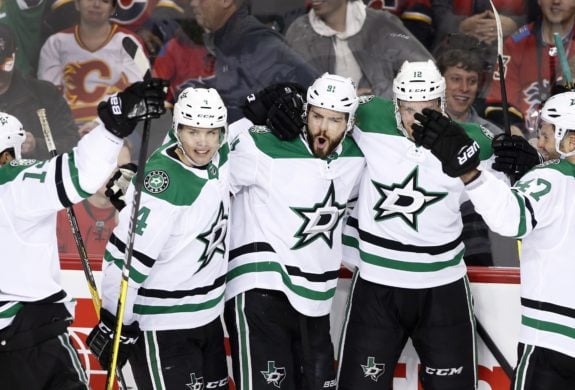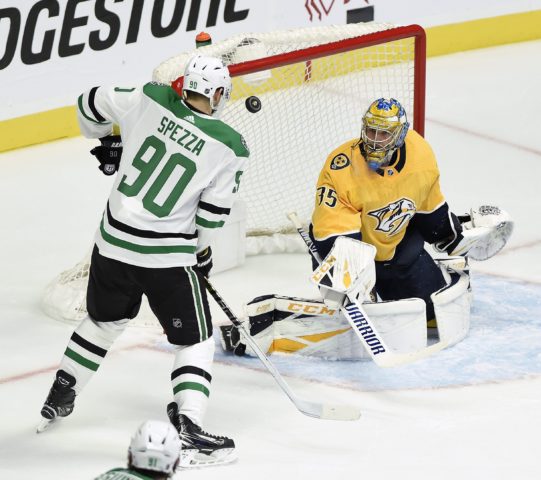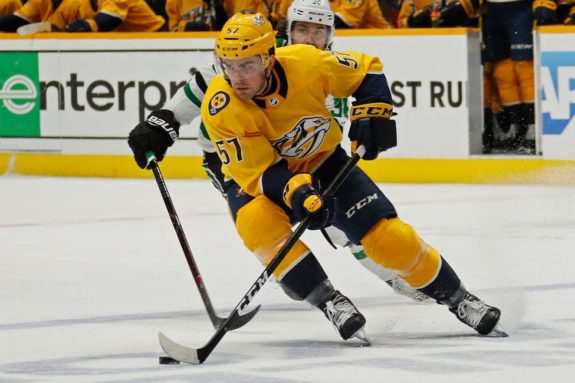The first two games have come and gone in the Nashville Predators/Dallas Stars series. Both teams have one win apiece, with the Stars taking Game 1 by a 3-2 score and the Predators winning the second game 2-1 in overtime. Here are some takeaways, both positive and negative, that I made.
Speed Is the Name of the Game
Although the Predators didn’t score any goals off the rush in either game, their speed was a strong factor in winning Game 2. With Brian Boyle out of the lineup and Wayne Simmonds going down early, the team’s slow-footed forwards were absent. Rocco Grimaldi, Boyle’s replacement, and Filip Forsberg double-shifting in Simmonds’ place meant the team had speed on all four lines. And this speed gave the Stars fits.
Related: How Do the Predators Stack up to the Stars?
The Predators’ speed allowed them to chase down dump-ins and start the cycle. Nowhere was this more evident than on Grimaldi’s game-tying goal in Game 2. Calle Järnkrok outworked Ben Lovejoy and sent the puck down low. Austin Watson beat Taylor Fedun to the puck, out-muscled him and sent a pass to an open Grimaldi, who buried the puck for his first career playoff goal. The Predators may not be able to match the Stars’ physicality or size, but they are the faster team and need to use that to their advantage.
More Disciplined Play
The Predators were shorthanded nine times in the first two games. That 4.5 per-game average is quite a bit higher than the 3.1 they averaged during the regular season. They actually committed 11 penalties, but two of them occurred as part of offsetting minors. The most egregious of the penalties occurred in Game 2 when Mattias Ekholm was rightfully called for interference. He disagreed with the call and mouthed off to the referee, leading to a double minor. He took a third penalty later in the game when he felt officials missed a slashing call on Dallas. But rather than playing it smart, he boarded/held/interfered with (take your pick) a Stars player, which led to the Predators being shorthanded again.
Thankfully, the penalty kill was up to the task in the first two games, killing off 8-of-9 power plays. But that’s not something the Predators should rely upon. The Stars’ power play scored at a 21 percent rate during the regular season, 11th-highest in the league. And with players like John Klingberg, Miro Heiskanen, Tyler Seguin, Jamie Benn and Alexander Radulov, the Stars have the personnel to make teams pay. The best way to ensure they don’t beat you is by staying out of the box. It’s a known fact that officials call fewer penalties in the postseason, but don’t give them something to look for. Keeping the game at five-on-five is the Predators’ best path to success.

Offense, Where Are You?
Through two games, both the Predators and Stars have scored four goals. This is unsurprising as both teams scored 14 goals during their regular-season series. Additionally, the Stars ranked second in goals against with 200 and the Predators tied for third with 212. So perhaps I shouldn’t be calling the team out to score more. Yet the fact remains that if the Predators don’t score, they won’t win. They controlled the shot battle in both games: 32-29 in Game 1 and 42-23 in Game 2. They even got to the high-danger areas.
In Game 1, the majority of shots came from either the goal mouth or the points. In Game 2, they diversified their shot locations with no high concentration from any one location. Instead, they took a number of shots from the goal mouth, low slot and the points. In terms of getting shots on net, they’re doing everything right. The Stars play a good defensive system and Ben Bishop has been stout in net all season. The Predators need to maintain their play and continue putting shots on net. They’re on the correct path to a series win.
Dominating Faceoffs
During the regular season, the Stars and Predators ranked fourth and fifth in faceoff percentage at 52.3 and 52 percent, respectively. Therefore, something close to a 50/50 split in the faceoff circle would be expected. However, that hasn’t happened. Instead, the Predators dominated the first two games, winning 60.5 percent of draws. They succeeded in all three zones – 64.8 percent in the offensive zone, 50 percent in the neutral zone and 62.5 percent in the defensive zone. Individually, Ryan Johansen won 66.7 percent of faceoffs and Nick Bonino won 75 percent. The only centerman who struggled was Kyle Turris, at 45 percent.

Matchup-wise, the Predators feasted on Seguin, especially in Game 1, when Johansen won 8-of-10 against him and Bonino won 4-of-5. Seguin fared better in Game 2, with Johansen only winning 3-of-7 and Bonino 3-of-6. However, both players won at least 57 percent against other centers.
Winning draws goes a long way to winning games. It helps obtain possession in the offensive zone, constricts opponents’ chances in the defensive zone or leads to an early clear on the penalty kill. Being successful at the faceoff dot helped the Predators be successful during the regular season, and continuing to do so in the postseason will be a key factor in winning the series.
Rinne with a Good Early Showing
If there was one key to the Predators going far in the postseason, it was Pekka Rinne providing consistency in net. For all the regular-season success he’s had in his career, he’s struggled in the playoffs, especially last season with a .904 save percentage and a 3.07 goals-against average. But so far in these playoffs he’s performed well.
He may have allowed three goals in Game 1, but only one was his fault. On that goal, he kicked out a rebound that landed on Mats Zuccarello’s stick. Had Bonino covered Zuccarello, the goal may not have happened. However, the rebound is still on Rinne. The other goals were both deflections – one off Ekholm’s glove and the other from Radulov after he cross-checked P.K. Subban out of the way. In total, Rinne stopped 26-of-29 saves and 5-of-7 at high-danger.

In Game 2, he was much better, stopping 22-of-23 shots and 4-of-5 at high-danger. He had no chance on the only goal he allowed after Ekholm turned the puck over on a clearing attempt. That blunder resulted in Seguin skating in on Rinne with Benn available for a pass. Rinne played the shot while Seguin saucered a pass over Subban’s stick and Benn batted the puck into the net. But Rinne also made some great saves, including a post-to-post save on Seguin after he gained separation from Ryan Ellis. Rinne looks dialed in this postseason, and that’s great news.
Josi & Subban Showing Up
If there’s one questionable aspect of the Predators’ play in the first two games it is their defense. With a top four that rivals any team’s, that group is expected to control play, both offensively and defensively. Yet, through two games, only Roman Josi and Subban have shown up. Both scored in Game 1 on nifty goals – Josi with a pretty backhander and Subban with a nice wrist shot after spinning off a defender. However, neither had great metrics in the first two games despite not committing egregious turnovers.
The same can’t be said for Ekholm, who had his best offensive performance during the regular season while still playing great defense. Yet through two games, he’s struggled. Sure, he’s tied for the team-lead with two points (both assists), but he had four giveaways in the two games, all in the defensive zone. Furthermore, he didn’t force any turnovers, giving him a minus-four differential. Sure it’s a small sample size, but it’s still alarming.
Related: P.K. Subban Peaking at the Right Time
Fabbro Fitting in Nicely
Meanwhile, there’s rookie defenseman Dante Fabbro, with his four games of NHL experience entering the postseason. Despite the lack of experience and with veterans Matt Irwin and Yannick Weber available, head coach Peter Laviolette stuck with Fabbro, and it’s been a good decision. Although he has only averaged 10:28 in the series with no points, he’s a plus-one and hasn’t been noticeable, one of the best compliments you can give to a young defenseman.

He played better in Game 2, with three shot attempts and four attempts that were blocked. Those are both good things. Add to it that he’s been steady in the defensive zone, winning races to loose pucks and making the proper reads on breakouts, and he’s confirmed Laviolette’s decision to play him. As he gets more comfortable, Fabbro should only continue to play better, meaning there’s no decline on the third pair.
Setting Themselves up for a Series Win
The first two games of the series weren’t ideal. A perfect script would have resulted in the Predators winning both games by at least two goals and having a stranglehold on the series as it heads to Dallas. That didn’t happen. However, there were positive aspects to how they played. Aspects that if maintained, in addition to fixing the negative parts, should lead to a series win and a spot in the Western Conference Semifinals.
*All stats from Hockey-Reference, Natural Stat Trick and Corsica Hockey